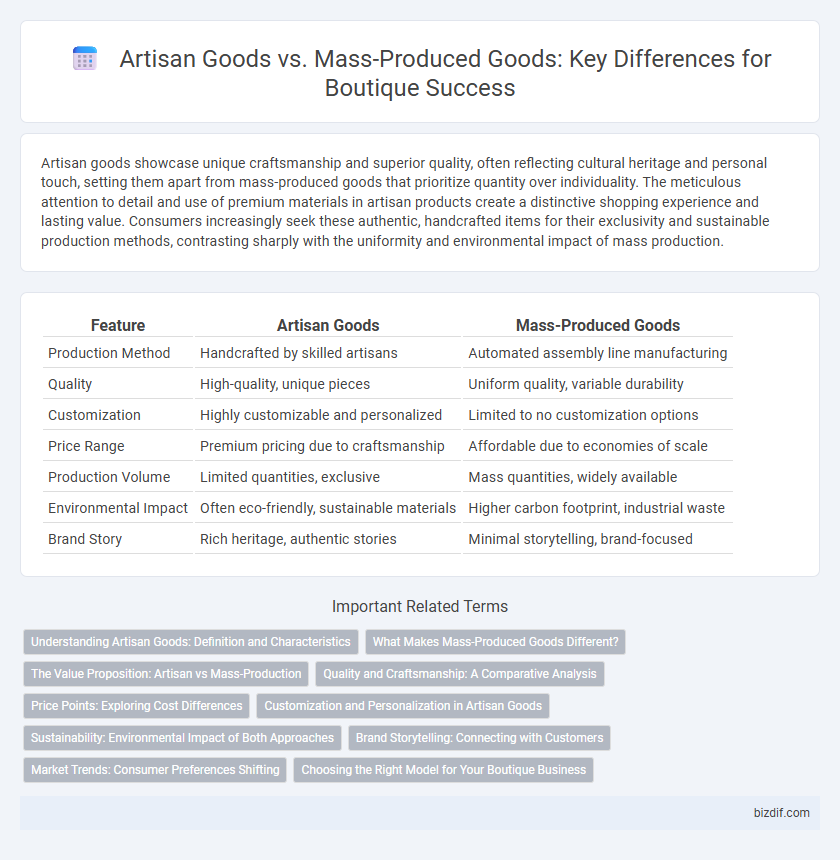Artisan goods showcase unique craftsmanship and superior quality, often reflecting cultural heritage and personal touch, setting them apart from mass-produced goods that prioritize quantity over individuality. The meticulous attention to detail and use of premium materials in artisan products create a distinctive shopping experience and lasting value. Consumers increasingly seek these authentic, handcrafted items for their exclusivity and sustainable production methods, contrasting sharply with the uniformity and environmental impact of mass production.
Table of Comparison
| Feature | Artisan Goods | Mass-Produced Goods |
|---|---|---|
| Production Method | Handcrafted by skilled artisans | Automated assembly line manufacturing |
| Quality | High-quality, unique pieces | Uniform quality, variable durability |
| Customization | Highly customizable and personalized | Limited to no customization options |
| Price Range | Premium pricing due to craftsmanship | Affordable due to economies of scale |
| Production Volume | Limited quantities, exclusive | Mass quantities, widely available |
| Environmental Impact | Often eco-friendly, sustainable materials | Higher carbon footprint, industrial waste |
| Brand Story | Rich heritage, authentic stories | Minimal storytelling, brand-focused |
Understanding Artisan Goods: Definition and Characteristics
Artisan goods are handcrafted products made in small quantities by skilled artisans, emphasizing quality, uniqueness, and traditional techniques. These items often feature natural materials and intricate details, reflecting the artisan's creativity and heritage. Unlike mass-produced goods, artisan products prioritize authenticity and individual craftsmanship, offering consumers a distinct, personalized experience.
What Makes Mass-Produced Goods Different?
Mass-produced goods are characterized by standardized production processes, enabling large quantities to be manufactured quickly and consistently, which often results in lower costs and wider availability. These products typically prioritize uniformity and efficiency over uniqueness, lacking the personalized touch and craftsmanship found in artisan goods. The use of automated machinery and assembly lines distinguishes mass-produced items from the handcrafted nature of boutique artisan products.
The Value Proposition: Artisan vs Mass-Production
Artisan goods offer unique craftsmanship, superior quality, and personalized detail that mass-produced goods often lack, appealing to consumers seeking authenticity and exclusivity. The value proposition of artisan products lies in their limited availability and the story behind each handcrafted item, which contrasts sharply with the uniformity and scale-driven pricing of mass-produced goods. This distinction drives higher perceived value and emotional connection, essential for boutiques aiming to differentiate themselves in competitive markets.
Quality and Craftsmanship: A Comparative Analysis
Artisan goods exhibit superior quality and craftsmanship due to meticulous handcrafting techniques and the use of premium, often locally sourced materials, ensuring uniqueness and durability. In contrast, mass-produced goods prioritize efficiency and cost reduction, often employing standardized processes and synthetic materials that can compromise individual product quality. Consumers seeking exclusive, well-crafted items tend to favor artisan products for their authenticity and attention to detail, which are less prevalent in mass-produced alternatives.
Price Points: Exploring Cost Differences
Artisan goods often command higher price points due to handcrafted quality, unique materials, and limited production, reflecting the skilled labor involved. Mass-produced goods benefit from economies of scale, resulting in lower costs and more affordable pricing for consumers. Price differences highlight the value consumers place on exclusivity and craftsmanship in boutique markets.
Customization and Personalization in Artisan Goods
Artisan goods offer unparalleled customization and personalization, as each item is meticulously crafted to meet individual preferences and specifications. Unlike mass-produced goods that follow standardized designs, artisan products reflect unique artistic expression and attention to detail. This tailored approach enhances the overall value and emotional connection for customers seeking exclusive, one-of-a-kind items.
Sustainability: Environmental Impact of Both Approaches
Artisan goods typically emphasize sustainability through the use of natural, locally sourced materials and small-batch production, minimizing waste and reducing carbon footprints. In contrast, mass-produced goods often rely on large-scale manufacturing processes that consume significant energy and generate more pollution and landfill waste. Choosing artisan products supports eco-friendly practices and promotes long-term environmental health by prioritizing quality and resource efficiency over quantity.
Brand Storytelling: Connecting with Customers
Artisan goods offer unique brand storytelling opportunities by emphasizing craftsmanship, heritage, and the creator's passion, fostering a deeper emotional connection with customers. Unlike mass-produced goods, these handcrafted items convey authenticity and exclusivity, enhancing brand loyalty and perceived value. This personalized narrative allows boutiques to differentiate themselves and build meaningful customer relationships based on trust and shared values.
Market Trends: Consumer Preferences Shifting
Consumer preferences are increasingly favoring artisan goods over mass-produced items due to growing demand for unique, handcrafted products that emphasize quality and sustainability. Market trends indicate a rising willingness among consumers to pay premium prices for artisan goods that support local craftsmanship and ethical production practices. This shift highlights a broader movement towards personalization and authenticity in retail, challenging traditional mass production models.
Choosing the Right Model for Your Boutique Business
Selecting artisan goods for your boutique emphasizes uniqueness, craftsmanship, and higher perceived value, attracting customers seeking exclusive and personalized items. Mass-produced goods offer consistency, lower costs, and wider variety, supporting scalable inventory and appealing to price-sensitive shoppers. Aligning your boutique's brand identity and target market preferences with either artisan or mass-produced products ensures optimal customer engagement and profitability.
Artisan Goods vs Mass-Produced Goods Infographic

 bizdif.com
bizdif.com